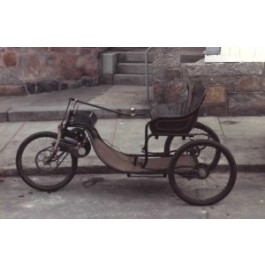|
|
DickinsonDescriptionThe Dickinson Morette was first manufactured in 1903 in Aston Brook Lane, Birmingham, (UK) by B.E. Dickinson Toledo Engineering Works. The single seater machine was powered by a 1.5 hp engine whilst the “sociable” two seater was powered by either a 2.5 hp or a 4 hp 2-cylinder engine. Both variations provided power to the front wheel by chain. Despite being very high the car was unique for its day in that it could be started from the drivers seat by means of a flexible chord that fitted into a groove in the flywheel. When pulled this would then fire up the engine. A pulley on the crank shaft was then brought into frictional driving contact with a rubber covered wheel on a lay shaft by lowering the steering tiller. This gave the Morette a top speed of around 12 - 15 mph. Lifting the tiller would lift the engine out of action whilst braking applied a double brake and cut off the fuel supply to the engine. Detailed Information
|




